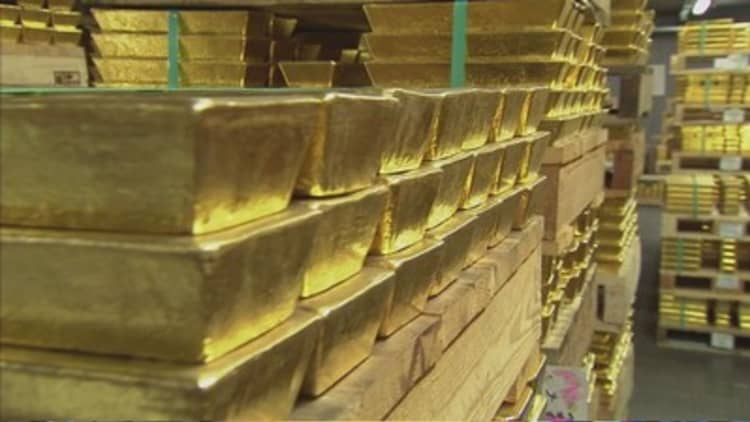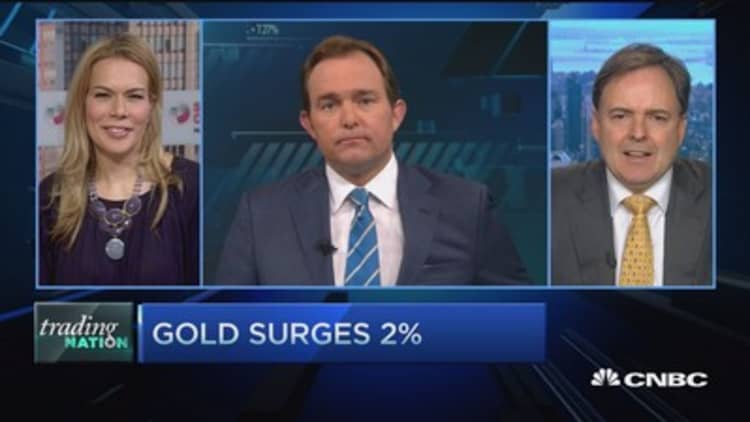
Gold demand continued to fall in the first quarter as the precious metal struggled to regain its shine among buyers amid weaker economic growth, higher bullion prices in local currency terms and rallying stock markets.
Overall demand totaled 1,079 metric tons during the first three months of the year – down 1 percent compared to the same period last year, and below the five-year quarterly average of 1,114 metric tons, the World Gold Council (WGC) said in its quarterly Gold Demand Trends report, published on Thursday.
Despite a volatile start to the year, gold prices ended the quarter where they started, around $1,183 an ounce. Spot gold last traded at $1,112.
Over the same period, equity markets in Asia – home to the world's top consumers of gold – soared 6 percent according to the MSCI Asia-Pacific Index, dulling the appeal of the yellow metal.
"Rallying domestic equity markets ate into Q1 gold demand in China, both investment and jewelry," the industry body wrote in the report. The benchmark rallied around 15 percent in the quarter.
"Although not overtly an investment, there is a strong investment motive to jewelry demand, which was undermined as Chinese consumers turned their attention to the stock markets, enticed by the rising trend," it added.
China vs India
Chinese consumer demand for jewelry – the most significant component of overall demand – fell 10 percent to 213 metric tons on year in the first quarter, outpacing global declines. Global jewelry demand slipped 3 percent to 601 metric tons in the quarter.
While Chinese buyers pull backed on bling purchases, the country remained the top source of demand globally.
Read MoreGold just signaled a sell sign—here's why: Trader
In India, jewelry demand stood at 151 metric tons, up 22 percent on year, following unusual weakness in the year-earlier period.
"The first quarter of last year saw a combination of factors discourage jewelry purchases: import curbs were in full force; approaching government elections created an atmosphere of uncertainty; and temporary restrictions were placed on free movement of cash and assets such as gold," WGC said.

Demand conditions in the most recent quarter were far more encouraging, it said.
"The outlook for the sector is healthy, particularly given upward revisions to GDP growth. And demand during the Akshaya Tritiya festival was buoyant, with retailers reporting growth of around 10-15 percent in sales over last year," the WGC said, referring to the Hindu festival considered to be auspicious for buying gold.
Read MoreOptions trader bets millions on speedy gold spike
"One caveat to bear in mind is that the unseasonal rains and hailstorms that hit some parts of the country in late March and early April may undermine some elements of rural demand," it noted.
While gold demand out of China and India tends to fluctuate due to domestic factors, they remain the two most important markets for the precious metal. Together, Asia's two biggest emerging economies accounted for 54 percent of total global consumer demand in the quarter.
Inflows trickle back into gold ETFs
Investment demand, the other key driver of the world's gold market, staged a moderate recovery, rising 4 percent to 279 metric tons in the quarter.
Gold-backed exchange traded funds (ETFs) saw net inflows of 26 metric tons, turning positive for the first time since the fourth quarter of 2012 as western investors warmed up to the previous metal, according to the WGC.
Meantime, central banks continued to add to their stockpiles, purchasing 119 metric tons in the quarter, flat compared with the year ago period.
This was the 17th consecutive quarter that central banks have been net purchasers of gold as they seek diversification away from the U.S. dollar, the WGC said.


